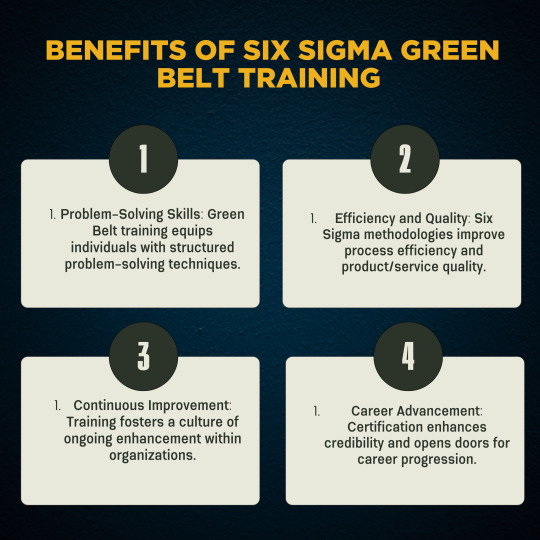Don't wanna be here? Send us removal request.
Text
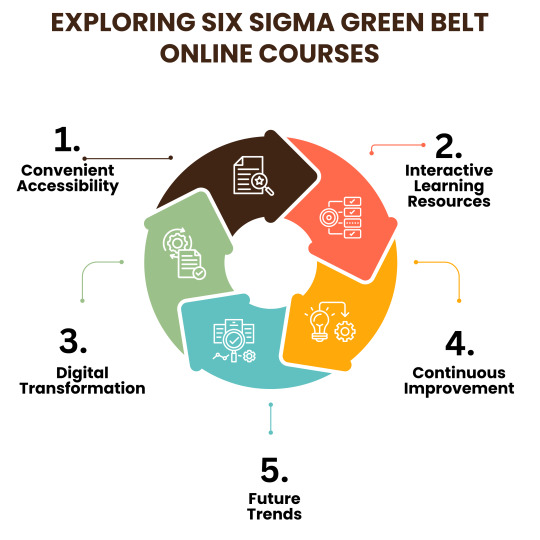
#six sigma green belt course online#six sigma green belt#lean six sigma green certification#six sigma green belt certification
0 notes
Text
Developing Efficiency: Examining Online Six Sigma Green Belt Courses
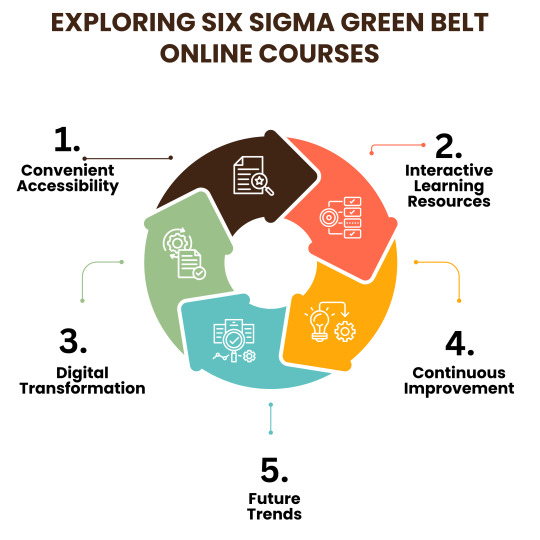
Continuous learning and skill development have become essential in today's cutthroat employment market. The Six Sigma certification stands out among the many professional development options as an indicator of competence in quality control and process optimization. The Six Sigma Green Belt certification is a starting point for individuals who want to learn more about operational excellence and gain insight into the concepts and practices that are critical to maximizing organizational performance.
A Six Sigma Green Belt certification used to require attending seminars and in-person training sessions. However, aspirant professionals now have the freedom to obtain certification from the comfort of their homes or offices thanks to the development of online learning platforms. To learn about the advantages and chances that come with Six Sigma Green Belt online courses, let's take a closer look at them.
Easy Access and Adaptability
The flexibility that comes with choosing an online Six Sigma Green Belt course is one of its biggest benefits. Due to the flexibility of online learning, students are able to manage their academic obligations with their personal and professional lives. Online courses adjust to your schedule rather than the other way around, regardless of your situation—you can be a full-time worker, student, or career transition.
Engaging Interactive Education
Many Six Sigma Green Belt programs include interactive multimedia content, quizzes, case studies, and virtual simulations to improve the learning experience—a misperception that online courses aren't engaging enough. These components offer practical insights into Six Sigma methodology applications in the real world in addition to reinforcing theoretical notions.
Cost-Effectiveness
Online Six Sigma Green Belt courses are frequently far less expensive than traditional classroom-based training. Students can also save money on study materials, lodging, and transportation costs. Due to its affordability, Six Sigma certification is now more widely available to professionals from a wider range of backgrounds and places.
Professional Guidance and Assistance
Reputable online platforms collaborate to create and distribute course content with industry experts and certified Six Sigma practitioners. This guarantees that during their certification process, students will receive excellent training, direction, and assistance. Dedicated teachers are on hand to help and clarify, whether you have concerns about statistical tools, project implementation, or job options.
Real-World Implementation and Project Management
The emphasis on project work and practical application is a defining characteristic of Six Sigma certification. Online courses incorporate project-based learning modules that allow learners to use Six Sigma approaches in simulated or real-world organizational contexts. In addition to reinforcing learning, this practical method gives students real-world skills they can use right away in their careers.
Internationally Accredited Certification
Participants in an authorized online Six Sigma Green Belt course earn a certification that is accepted throughout the world upon successful completion. Employers view this certification as a validation of their expertise in Six Sigma processes and as a way to increase their reputation and marketability. Your possibilities for career advancement within your current business or in new industries can be greatly enhanced by earning a Six Sigma certification.
To sum up
Six Sigma Green Belt online courses provide an easy, affordable, and thorough way to learn the fundamentals of quality control and process optimization. Through the use of interactive learning environments, knowledgeable education, real-world application, and internationally recognized certification, these programs enable aspiring professionals to advance organizational excellence and significantly impact their areas. Investing in a Six Sigma certification can be a game-changer for your professional and personal development, regardless of your experience level or time since graduation.
#six sigma green belt#six sigma certification#six sigma green belt course online#green belt certification
1 note
·
View note
Text

0 notes
Text
Gaining Proficiency: An Overview of Lean Six Sigma Programs
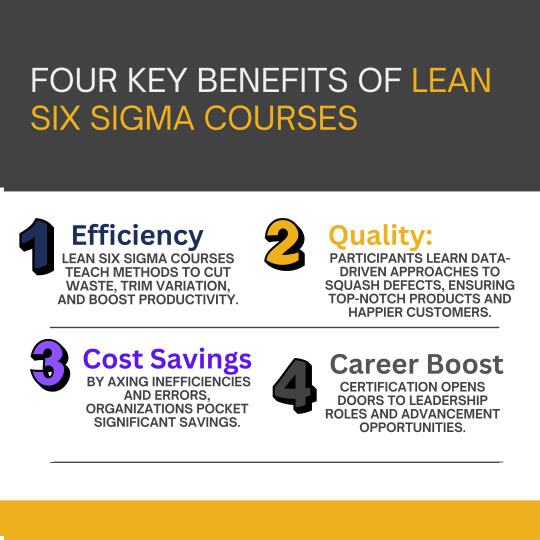
In the current competitive business environment, companies are always looking for methods to increase productivity, cut expenses, and improve overall quality. Lean Six Sigma is one approach that has become very popular for accomplishing these objectives. This methodology, which combines the ideas of Lean Manufacturing and Six Sigma, is centered on removing waste, reducing variance, and streamlining procedures to provide the most value to clients.
Lean Six Sigma courses can be a game-changer if you want to learn the art of efficiency and become a highly sought-after practitioner in your sector. These courses include thorough training and certification programs that are intended to give people the abilities and information required to spearhead process improvement projects inside their companies. Here's all the information you need to know about Lean Six Sigma courses, regardless of your level of experience.
Knowing Lean Six Sigma
Let's first explore the fundamental ideas of Lean Six Sigma technique before getting into the finer points of these courses.
Lean Manufacturing: Derived from Toyota's manufacturing methodology, Lean focuses on finding and getting rid of waste in processes. Any activity that does not provide value from the standpoint of the client is considered waste in this sense. The lean concepts prioritize constant improvement, human dignity, and an unwavering quest for excellence.
Six Sigma: Developed by Motorola and made popular by businesses such as General Electric, the goal of Six Sigma is to decrease process variation and faults. It employs statistical tools, a data-driven strategy, and techniques such as DMAIC (Define, Measure, Analyze, Improve, Control) to produce results that are consistently high-quality and processes that are methodically improved.
Advantages of Lean Six Sigma Courses
Improved Skillset: Participants in Lean Six Sigma courses receive an extensive toolset of approaches, instruments, and procedures for process improvement. Through the use of value stream mapping and root cause analysis, participants have the ability to spot areas for improvement and put workable solutions in place.
Career Advancement: Having a Lean Six Sigma certification can greatly improve your chances of getting ahead in your present position or moving on to a new one. Employees with Lean Six Sigma certification are highly valued by many companies because they can provide observable advantages including cost savings, increased productivity, and higher quality.
Organizational Impact: Cycle time, defect rates, and customer satisfaction are just a few of the important performance measures that organizations may significantly improve by putting Lean Six Sigma principles into practice. Skilled individuals are essential in propelling these projects forward and guiding groups of people toward achievement.
Problem-Solving Skills: Lean Six Sigma courses impart a problem-solving mentality in addition to process improvement techniques. In today's data-driven world, participants gain vital skills by learning how to approach problems methodically, collect and evaluate data, and create data-driven solutions.
Selecting the Best Course for Lean Six Sigma
It's crucial to take a number of things into account when choosing a Lean Six Sigma course to make sure you get excellent instruction that supports your aims. Here are some crucial things to remember:
Finding courses that have been accredited by respectable institutions like the International Association for Six Sigma Certification (IASSC) or the American Society for Quality (ASQ) is advised. Quality assurance and rigorous adherence to standards are provided by accredited courses.
Curriculum: Examine the course syllabus to make sure that fundamental Lean Six Sigma techniques and concepts—like DMAIC, root cause analysis, and statistical tools—are covered. Seek out classes that provide a good mix of both theory and real-world application.
Expertise of the Instructor: Take into account the credentials and background of the instructors who are teaching the course. Skilled educators possessing actual knowledge in the field can offer significant perspectives and useful illustrations that augment the educational process.
Flexibility: Evaluate the course format's adaptability, taking into account possibilities for instructor-led instruction, self-paced study, and online learning. Select a format based on your preferred learning style and timetable.
Price: Cost is a consideration, but it's crucial to balance it with the caliber of instruction and possible return on investment. Instead of selecting courses only on the basis of cost, consider the value they provide in terms of certification and knowledge.
In summary
Organizations require qualified people who can promote continuous development and produce measurable results in the fast-paced business world of today. A tested method for gaining the knowledge and proficiency required to succeed in roles involving process improvement is provided by Lean Six Sigma courses. People can become catalysts for good change, improve their career chances, and meaningfully contribute to their organizations by selecting the appropriate course and earning certification. So why hold off? Become proficient in efficiency by enrolling in Lean Six Sigma courses right now!
#lean six sigma certification#lean six sigma courses#six sigma black belt certificatiob#six sigma black belt online course
0 notes
Text

#lean six sigma certification#lean six sigma green belt#green belt certification#six sigma green belt#six sigma certification
0 notes
Text
Unlocking Efficiency: The Value of Lean Six Sigma Certification

Organizations often look for ways to improve productivity, cut down on waste, and streamline procedures in their pursuit of operational excellence. Of all the efficiency-driven methodologies available, Lean Six Sigma is a particularly powerful framework. This strategy, which combines the ideas of Six Sigma processes with Lean manufacturing, has completely changed industries all over the world. And at the core of this revolutionary approach is certification, a license that opens doors to new prospects while also validating one's skills.
Knowing Lean Six Sigma
Let's first explore the fundamentals of Lean Six Sigma before discussing the importance of certification. Lean Six Sigma is a methodology that originated in manufacturing and is now widely used in a variety of industries, including software development, healthcare, and finance. Its goal is to maximize value while eliminating waste.
Lean emphasizes streamlining a process, encouraging a continuous improvement mindset, and locating and removing non-value-added operations. It places a strong emphasis on ideas like just-in-time manufacturing, cutting lead times, and giving staff members the freedom to quickly recognize and address issues.
Contrarily, Six Sigma focuses on minimizing variance and errors to guarantee that operations adhere to strict guidelines. Six Sigma targets near-perfection, with no more than 3.4 defects per million opportunities, by using statistical tools and procedures.
The Influence of Accreditation
Although the Lean Six Sigma concepts are strong enough on their own, certification lends legitimacy and expertise. Why it matters is as follows:
Verification of Expertise: Certification attests to a person's mastery of Lean Six Sigma techniques. It denotes a person's capacity to successfully lead process improvement initiatives and produce measurable outcomes for businesses.
Worldwide Recognition: Lean Six Sigma certifications are accepted outside of industry borders on a worldwide scale. Whether you work in the healthcare, manufacturing, or service industries, having this credential denotes a standard level of proficiency.
Career Advancement: Lean Six Sigma certification distinguishes individuals in today's cutthroat employment market. It provides access to a wide range of employment options in various industries, from executive positions to entry-level jobs.
Impact on Organizations: Organizations benefit instantly from the expertise of certified professionals. They improve operations, improve quality, and produce cost savings by leading process improvement efforts, all of which benefit the bottom line.
Culture of Continuous Learning: Becoming certified in Lean Six Sigma is a path of ongoing education rather than a single accomplishment. Keeping up with the latest methodology and best practices, certified experts encourage innovation and growth inside their organizations.
Selecting the Appropriate Certification
The selection of an appropriate certification level is contingent upon a number of factors, including industry standards, present knowledge, and career aspirations. The following are the main Lean Six Sigma certification levels:
Yellow Belt: Foundational knowledge of Lean Six Sigma principles and processes is provided by this entry-level certification.
Professionals with a greater understanding of Lean Six Sigma tools and procedures who are working on process improvement initiatives can get the intermediate Green Belt certification.
Black Belt: A higher level of certification for managers and project leaders that attests to their proficiency in statistical analysis and Lean Six Sigma techniques.
Master The ultimate qualification, known as the Black Belt, is only awarded to those who have attained a high level of proficiency in Lean Six Sigma and are frequently used as coaches and mentors in businesses.
In summary
When quality and efficiency are the most important factors, Lean Six Sigma certification becomes a powerful tool for achieving organizational success. It's more than just a certification; it's evidence of a person's dedication to excellence and ongoing development. Professionals who invest in certification improve not only their own career opportunities but also the organizations they work for by creating measurable value. Therefore, pursuing Lean Six Sigma certification is definitely useful, whether your goal is to improve the performance of your firm or to start a career in process improvement.
#lean six sigma green certification#lean six sigma certification#green belt certification#six sigma green belt#six sigma green belt course#lean six sigma green belt course
0 notes
Text

#lean six sigma green belt certification#lean six sigma green belt#six sigma green belt#green belt certification
0 notes
Text
Understanding Effectiveness: A Handbook for Lean Six Sigma Green Belt Accreditation

Organizations are continuously looking for ways to improve productivity, reduce waste, and streamline operations because they know that efficiency is essential for success in today's world. Lean Six Sigma is a potent combination of Six Sigma techniques and Lean principles that has become a game-changing strategy for attaining operational excellence. The Green Belt accreditation, a highly sought-after title that denotes competence in promoting process changes, is the foundation of this system. Let's examine what it means to get certified as a Lean Six Sigma Green Belt and why it's an advantageous skill in the current competitive environment.
Knowing Lean Six Sigma
Let's first discuss the basics of Lean Six Sigma before delving into the importance of the Green Belt certification. The Toyota Production System is the source of lean concepts, which emphasize reducing waste, maximizing flow, and increasing value for customers. The goal of Six Sigma, which was developed by Motorola and made popular by General Electric, is to attain near-perfect quality by minimizing errors and variance in processes. Lean Six Sigma provides an all-encompassing strategy to continuous improvement by combining speed and precision through the integration of various approaches.
The Green Belt's Function
As front-line issue solvers and project managers, Green Belts are essential members of the Lean Six Sigma hierarchy. These people can spearhead improvement projects in their respective fields because they have a strong grasp of Lean Six Sigma principles and technologies. Green Belts oversee initiatives targeted at raising productivity, quality, and customer happiness. These initiatives may involve reducing production procedures, boosting service delivery, or strengthening administrative workflows.
Green Belt Certification: Obtaining this certification demonstrates that one has mastered the principles of Lean Six Sigma and is adept at implementing them in practical settings. Essential topics including process mapping, data analysis, root cause analysis, statistical tools, and the DMAIC (Define, Measure, Analyze, Improve, Control) methodology are typically covered in Green Belt training programs. After a demanding training program, candidates take a certification exam to evaluate their knowledge and problem-solving abilities.
Advantages of Becoming a Certified Green Belt:
1. Improved Ability to Solve Problems:
With the help of green belt training, people may solve problems more methodically by determining the underlying causes of issues, evaluating the facts, and putting workable solutions into place. These abilities are extremely valuable in all fields, enabling businesses to take on challenging tasks and promote long-term progress.
2. Leadership Development
Earning a Green Belt credential develops leadership qualities in addition to technical proficiency. In order to support change projects, Green Belts get experience leading cross-functional teams, communicating clearly, and influencing stakeholders. Fostering a culture of continuous improvement and accelerating organizational transformation require these qualities in a leader.
3. employment Advancement
A Green Belt certification will greatly improve employment possibilities in the competitive work market of today. Professionals with Lean Six Sigma experience are highly valued by employers, who see them as catalysts for achieving measurable outcomes and advancing operational excellence. Certified Green Belts are in a good position to grow in their careers, whether they're looking to move up the corporate ladder or take advantage of new chances.
4. Cost Savings and Efficiency benefits
Green Belt initiatives frequently result in significant cost savings and efficiency benefits because they optimize processes and minimize waste. Lean Six Sigma programs have an influence that goes beyond individual projects and improves customer happiness, cycle times, and product quality while also generating financial gains for businesses.
In summary,
companies need to continuously pursue excellence in a fast-paced business climate that is marked by intense competition and changing client needs. Professionals with a Lean Six Sigma Green Belt certification are prepared to create operational improvements and provide measurable business outcomes because they have the necessary knowledge, abilities, and credentials. Whether you are a rising star in your area or a seasoned industry veteran, investing in Green Belt training can open doors for career advancement, personal development, and organizational success. In today's changing environment, embrace the path to mastery and realize Lean Six Sigma's full potential.
Lean Six Sigma Green Belt certification is a lighthouse of expertise in the quest of excellence and efficiency, pointing people and organizations in the direction of a better, more productive future.
#lean#lean six sigma green certification#gree#lean six sigma green belt certification#green belt#green belt certification
0 notes
Text
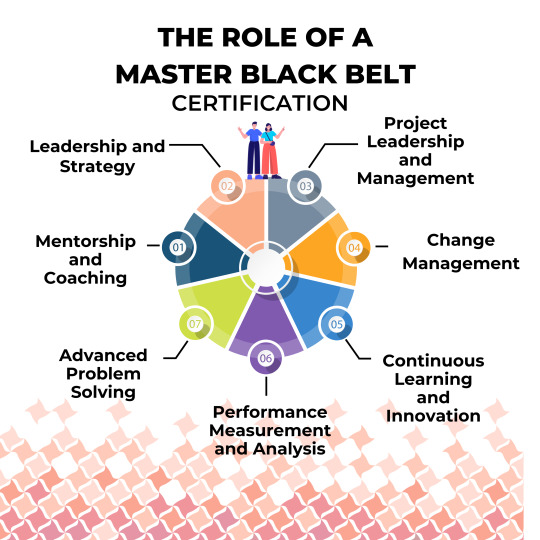
0 notes
Text
Developing Your Knowledge of Master Black Belt Certification to Become a Master of Quality

Achieving mastery in the fields of quality management and process improvement is a journey rather than a destination. Getting certified as a Master Black Belt is one important step on this route. It is evidence of a person's skill, background, and commitment to fostering organizational success. Let's explore the benefits of Master Black Belt certification in the quality management industry and what it includes.
Master Black Belt Certification: What Is It?
In Six Sigma methodology, earning the Master Black Belt (MBB) certification represents the highest level of success. Six Sigma is a data-driven methodology that aims to achieve near-perfection in quality by removing variances and errors from operations. In an organization, Master Black Belts are the top mentors and executives who oversee several Six Sigma projects, train Black Belts and Green Belts, and advise senior management on strategic matters.
The Way to Get Expertise
A Master Black Belt does not become one overnight. It calls for a great deal of commitment, experience, and knowledge of Six Sigma concepts and procedures. Usually, the process entails the following crucial steps:
Foundational Training: Individuals usually begin with fundamental training in Six Sigma methodology prior to pursuing the rank of Master Black Belt. This frequently entails earning Black Belt and Green Belt certifications, accumulating practical project management experience, and using statistical tools.
Professional Experience: Experience is the key to mastery. Candidates for Master Black Belt positions typically have years of hands-on experience managing and carrying out Six Sigma projects in a variety of fields and sectors. Through this experience, they strengthen their ability to solve problems and broaden their knowledge of process improvement techniques.
Advanced Certification and instruction: Following a significant amount of Black Belt experience, students can pursue Master Black Belt-specific advanced instruction. In order to effectively guide and teach other Six Sigma practitioners, this course delves deeper into advanced statistical analysis, leadership, change management, and coaching strategies.
Project Portfolio: To be certified as a Master Black Belt, candidates must effectively lead and finish a portfolio of intricate and significant Six Sigma projects. These projects demonstrate their capacity to improve organizational effectiveness, produce measurable business results, and achieve notable improvements in key performance measures.
Evaluation and Certification: The last phase entails an evaluation of the candidate's abilities, expertise, and accomplishments using the Six Sigma approach by a certifying authority. The esteemed Master Black Belt credential, which acknowledges them as leaders and experts in the field of quality management, is given to qualified candidates.
A Master Black Belt's Role
Master Black Belts are essential for promoting corporate excellence and a continual development mindset. Among the principal duties are:
Strategic Leadership: Master Black Belts work with top management to match overarching business objectives and strategies with Six Sigma efforts. They find areas where processes can be improved and rank the initiatives that will benefit the company the most.
Mentoring and Coaching: Throughout the project lifetime, Master Black Belts offer advice, assistance, and experience to Black Belts and Green Belts in their capacity as mentors and coaches. They guarantee the effective completion of improvement initiatives by assisting Six Sigma practitioners in honing their skills and talents.
Advanced Problem Solving: Master Black Belts use their in-depth understanding of statistical techniques and tools to address difficult issues and obstacles in the workplace. They employ data-driven methodologies to pinpoint underlying issues, put fixes in place, and promote long-lasting transformation.
Constant Learning and Innovation: Master Black Belts are dedicated to constant learning and innovation because they are leaders in the quality management industry. They promote continuous innovation and excellence by keeping up with the latest developments in Six Sigma and quality improvement trends, best practices, and technology.
The Importance of Being a Master Black Belt
A Master Black Belt certification is more than simply a title; it's a mark of distinction and proficiency in the field of quality control. Businesses that make investments in the training of Master Black Belts gain:
Improved Performance: Master Black Belts contribute significantly to gains in productivity, quality, and efficiency, which boost an organization's ability to compete in the market.
Cost Savings: Master Black Belts assist companies in realizing significant cost savings and operational efficiencies by locating and removing waste, flaws, and variances in processes.
Culture of Excellence: Master Black Belts are essential to the organization's promotion of both continuous improvement and an excellence culture. Teams are motivated by their leadership to pursue excellence and welcome change as a source of opportunity for development and creativity.
Organizations that have a group of Master Black Belts in place are better positioned to lead their industry in terms of quality, innovation, and customer happiness. This gives them a strategic advantage in the marketplace.
To sum up
The Master Black Belt designation is the highest honor in the Six Sigma methodology, given to those who have proven to be exceptionally knowledgeable, capable, and committed to advancing organizational excellence. Organizations may achieve operational excellence, leverage the full potential of their workforce, and keep a competitive edge in the fast-paced business world of today by investing in the development of Master Black Belts.
0 notes
Text

#lean six sigma black belt#six sigma black belt certificatiob#black belt certification#lean six sigma black belt certification
0 notes
Text
The Function of Lean Six Sigma Black Belts in Increasing Productivity

In the dynamic world of business, productivity is critical. To remain competitive, companies in all industries—manufacturing, healthcare, finance, and so on—strive to streamline operations, cut waste, and improve quality. This quest gave rise to techniques such as Lean Six Sigma, whose practitioners are frequently compared to masters of martial arts; the Lean Six Sigma Black Belt represents the highest level of this proficiency.
Exposing the Idea
The term "Black Belt" is derived from martial arts and conjures up thoughts of expertise and mastery. It denotes the pinnacle of proficiency in the field of Lean Six Sigma. But what does it actually involve?
Fundamentally, Lean Six Sigma blends two potent techniques: Six Sigma, which strives to lower errors and variance, and Lean, which concentrates on reducing waste and increasing efficiency. Black Belts are the experts who expertly use these instruments to lead companies through challenging improvement initiatives.
What a Black Belt Does
A Six Sigma Lean A Black Belt is a dedication to effecting change and producing outcomes, not just a label. These experts are skilled in seeing areas that could use better, analyzing data to find the source of problems, and putting long-term fixes into action. They are invaluable assets in any firm because of their multifaceted job, which includes project management, statistical analysis, and leadership.
An overview of the contributions made by a Black Belt is as follows:
Leadership: Black Belts encourage teams to embrace continual development by acting as change agents. They cultivate an innovative and accountable culture by setting an exemplary example.
Problem Solving: Equipped with a variety of approaches and statistical instruments, Black Belts take on challenging issues head-on. They use methods like DMAIC (Define, Measure, Analyze, Improve, Control) to approach problems methodically and produce significant outcomes.
Data analysis: Being able to derive useful insights from large amounts of data is crucial in the modern era. Experts in statistical analysis, Black Belts use data to confirm theories, spot patterns, and inform their conclusions.
Project Management: The success of a project depends on its effective management. Black Belts are adept at precisely planning, carrying out, and overseeing projects to guarantee on-time delivery and stakeholder satisfaction.
The Path to the Black Belt
How to Become a Lean Six Sigma Being a Black Belt is no simple task. It calls for commitment, instruction, and practical experience. Usually, the trip consists of multiple stages:
Training: To learn Lean Six Sigma ideas, processes, and tools, Black Belt candidates go through a rigorous training program. This frequently entails case studies, practical projects, and classroom training.
Certification: After training, candidates have to pass certification tests to show that they are proficient. Obtaining Black Belt certification demonstrates a thorough comprehension of Lean Six Sigma concepts and the capacity to use them successfully.
Project Experience: Practical experience is the key to actual expertise; theory can only take you so far. Candidates for the Black Belt must oversee and finish numerous improvement initiatives while using their expertise to solve practical problems.
Ongoing Education: Getting certified is only the first step in the process. Black Belts are lifelong learners who are always looking for new ways to advance their knowledge and keep up with developments in the field.
Effects and Advantages
Lean Six Sigma Black Belts have a significant impact that goes well beyond specific projects. Businesses that invest in Black Belt personnel gain a variety of advantages, such as:
Cost reduction: Black Belts assist businesses in cutting expenses and raising profitability by getting rid of waste and optimizing workflows.
Quality Improvement: Black Belts raise the caliber of their goods and services by constant observation and in-depth analysis, which increases client happiness.
Enhanced Efficiency: Black Belts raise operational efficiency by streamlining processes and getting rid of bottlenecks, which helps businesses accomplish more with less.
Cultural Transformation: Black Belts are essential in molding company culture, empowering staff members at all levels, and establishing a continual improvement mentality.
In summary
Organizations need to continuously evolve and adapt in today's fast-paced business climate in order to be competitive. Six Sigma Lean Black Belts are the masterminds behind this change, using their knowledge to promote effectiveness, excellence, and creativity. They are invaluable resources that lead organizations toward excellence one project at a time as stewards of change. Thus, keep in mind that a Lean Six Sigma Black Belt is someone who has a great deal of knowledge, expertise, and commitment to improving the world behind their designation.
#lean six sigma certification#lean six sigma black belt#lean six sigma black belt certification#black belt certification
0 notes
Text

#lean six sigma certification#lean six sigma green certification#six sigma green belt#green belt certification
0 notes
Text
Unlocking Productivity: Lean Six Sigma Green Belt

Efficiency is crucial in today's business environment. The capacity to improve quality, reduce waste, and streamline operations can be crucial to the success of any business, no matter how big or small. This is where Lean Six Sigma comes into play, and becoming certified as a Green Belt in the methodology can greatly improve both your professional and organizational change-making abilities.
Knowing Lean Six Sigma
Lean Six Sigma is a methodology that combines two potent techniques: Six Sigma, which stresses decreasing faults and variances in operations, and Lean, which concentrates on cutting waste and improving processes. When combined, they offer a strong foundation for raising quality and productivity across a range of industries.
The DMAIC (Define, Measure, Analyze, Improve, Control) process, which offers an organized method for problem-solving and process improvement, is the foundation of Lean Six Sigma. With the help of this methodology, people and groups can find the core causes of problems, put data-driven solutions into practice, and maintain gains over time.
A Lean Six Sigma's Role Green Belt
A major achievement in the Lean Six Sigma hierarchy is the Green Belt certification. Professionals with a deep understanding of the Lean Six Sigma technique and associated instruments, known as "Green Belts," are essential in spearheading improvement initiatives inside their companies.
The following are the principal duties of a Lean Six Sigma Green Belt:
Project Leadership: Using the DMAIC technique to produce measurable results, Green Belts oversee improvement projects from inception to completion. They work together with stakeholders, other team members, and subject matter experts to find areas for improvement and put workable solutions in place.
Data analysis: Green Belts are skilled in this area and use statistical tools to evaluate process performance and pinpoint opportunities for improvement. To follow the effects of process improvements and make well-informed decisions, they collect and analyze data.
Green Belts possess the ability to solve problems expertly. They can pinpoint the underlying causes of problems and put long-term fixes into place. Utilizing techniques like process mapping, brainstorming, and root cause analysis, they take on challenging issues and promote ongoing development.
Change Management: Green Belts are aware of how crucial change management is to the accomplishment of process improvement projects. They handle change opposition, maintain excellent stakeholder communication, and make sure that advancements are embraced and maintained across the entire company.
Gaining Experience with Lean Six Sigma Green Belt Accreditation
How to Become a Lean Six Sigma There are several advantages to being a Green Belt for both persons and businesses.
Professional Growth: Attaining a Green Belt certification strengthens your record and showcases your proficiency in process optimization and issue resolution. It raises your earning potential and creates new employment opportunities.
Better corporate Performance: By cutting waste, improving quality, and raising productivity, Green Belts contribute to quantifiable gains in corporate performance. Businesses that use Lean Six Sigma experience considerable cost reductions as well as competitive benefits.
Improved Ability to Solve Problems: Critical thinking and analytical abilities are developed through the demanding training and certification procedure, which are beneficial in any professional setting. Green Belts gain a methodical approach to problem-solving, which improves decision-making and produces more effective solutions.
Cross-Functional Collaboration: By dismantling departmental silos and advancing a continuous improvement culture, Lean Six Sigma encourages cooperation across disciplines and departments. Working with teams from various backgrounds, Green Belts develop strong networks within their organizations and acquire insightful knowledge.
In summary
Organizations must always work to enhance their performance and optimize their operations in the fast-paced commercial world of today. To achieve these objectives, Lean Six Sigma offers a tried-and-true framework, and earning a Green Belt certification gives people the know-how and abilities to effect real change.
Investing in Lean Six Sigma training can alter your life, whether you're a seasoned professional aiming to develop your career or a recent graduate looking to stand out in the job market. You will improve your personal skills and help your company become more successful and competitive by earning a Green Belt certification.
0 notes
Text
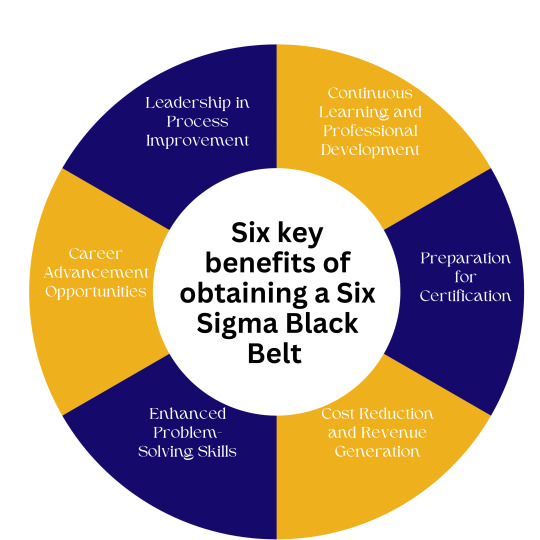
#lean six sigma black belt#six sigma certification#six sigma black belt certificatiob#six sigma green belt certification
0 notes
Text
Mastering Excellence: A Guide to Six Sigma Black Belt Certification

Within the realm of process improvement and quality management, Six Sigma is a shining example of excellence. It's an approach that seeks to reduce process variances and systematically eliminate faults in order to improve organizational performance. Six Sigma's strict training programs are the foundation of its success, and earning a Six Sigma Black Belt certification represents the highest level of performance in this industry.
Comprehending the Six Sigma Black Belt Certification
Being certified as a Six Sigma Black Belt is more than simply a mark of pride; it's an indication of one's proficiency in applying Six Sigma techniques to produce notable business gains. As opposed to the Green Belt, which emphasizes comprehension and implementation of fundamental concepts, the Black Belt certification goes farther into project management, statistical analysis, and leadership abilities.
How Can One Become a Black Belt in Six Sigma?
A Six Sigma Black Belt is not a title that should be taken lightly. It calls for commitment to quality, passion for process development, and dedication. This is a summary of the usual route:
While there aren't any hard requirements to enroll in the Six Sigma Black Belt course, it can help to have some prior knowledge or expertise in process improvement or quality management.
Training: The Black Belt course includes a wide range of topics, including advanced statistical analysis, regression analysis, hypothesis testing, design of experiments (DOE), and more. It usually lasts several weeks. Participants gain knowledge on how to mentor Green Belts, oversee challenging improvement initiatives, and interact with stakeholders in a productive manner.
Project Execution: Completing a real-world improvement project is a major requirement for the Black Belt certification. It is required of candidates to pinpoint areas in which their company needs to improve, use Six Sigma techniques to solve those issues, and provide quantifiable outcomes.
Exam: Candidates must pass a thorough exam measuring their knowledge of Six Sigma concepts, methods, and tools in order to obtain the Six Sigma Black Belt certification.
Certification: Candidates are granted the highly sought-after Six Sigma Black Belt certification, confirming their proficiency in process improvement, upon successfully completing the training, project, and exam.
Six Sigma Black Belt Certification Benefits
Promotion in Career: A Six Sigma Black Belt certification can lead to a plethora of job growth prospects. Companies in all sectors place a high value on people who can lead process improvements and provide measurable outcomes.
Greater Earning Potential: Black Belts who are proficient in Six Sigma techniques are paid more than those who are not certified. A certification can lead to profitable professional prospects and acts as a proof of one's ability.
Impact on the Organization: Black Belts are essential to fostering organizational excellence. They assist companies in increasing productivity, cutting expenses, and providing customers with better goods and services by overseeing improvement initiatives and training Green Belts.
Constant Learning: Six Sigma is an attitude as much as a credential. Black Belts possess a toolset of potent problem-solving strategies that they can use to tackle a variety of obstacles in their professional lives.
In summary
Organizations are continuously looking for methods to increase customer happiness, save waste, and improve efficiency in today's competitive business environment. Six Sigma Black Belt specialists play a crucial role in accomplishing these objectives by applying their knowledge of statistical analysis and process improvement. A smart investment in your future success, obtaining Six Sigma Black Belt certification can help you progress your career or bring about significant change within your firm. It's a path that promises great benefits on the personal and professional fronts but also requires commitment and tenacity. Are you prepared to start your journey toward mastery?
#six sigma green belt#six sigma black belt certificatiob#six sigma black belt online course#black belt course
0 notes
